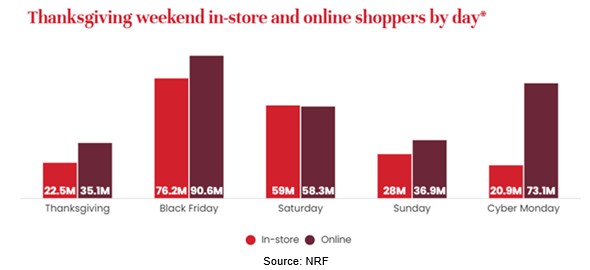
The following is an archived collection of our weekly insights through the month of December. Those who had signed up to our Interlog Insights newsletter received each week’s update to their inbox on the original release date. If you like what you see below, please feel free to sign up yourself to get these updates right as they come!
This month's insights
- Suez Canal Concerns
- Holiday Spending and Travel
- Labor Uncertainty
- Bed Bath & Beyond's Lawsuit
Week 3 - Originally released December 15
Insight: Like the Panama Canal, the Suez Face Uncertainty
It’s apparent that the Panama Canal is in dire straits. The waterway’s drought-related restrictions on oceangoing traffic will worsen before getting any better. From load limits to surcharges, it’s becoming increasingly unwise to make reservations at this trade throughway.
As a result, and a development covered in November’s Interlog Insights, rerouting from Asia via the Suez Canal has captured the intrigue of transpacific services to U.S. East and Gulf coasts.
In a vacuum, the strategy liberates importers from the Panama Canal’s outstanding disruptions. However, global trade does not exist in a vacuum. It’s vulnerable to other risks across the world. Whether that’s climate-related, like the Panama Canal, or even geopolitical tensions, as soon revealed with the Suez Canal.
Yemen rebel group targets Israeli-linked ships
Suez transits are facing potential peril as instability in the Middle East has escalated following the Israel-Hamas war. Houthis, a militant rebel group based in Yemen, have been targeting ships with associations to Israel along the Bab-el-Mandeb Strait, between the Red Sea and the Gulf of Aden.
At first, it was believed only Israel-linked vessels would be at immediate risk, however the other week a Norwegian-flagged tanker and a Hong Kong-based OOCL containership were both attacked.
There’s speculation that Houthis track and locate ships using online vessel tracking platforms and port data. This information is not difficult to acquire and is often available to the public.
In response, ships have taken security measures to ward off these opportunistic insurgents.
Courtesy of mapping by maritime data provider MarineTraffic, many ships transiting the Suez have marked their destinations implying they have armed guards onboard. Many of them are not bluffing either.
Last week, the Houthis reiterated that they would attack all ships along the strait, as well as the Red Sea (which connects to the Suez Canal).
While it’s unclear whether the attack on the OOCL containership was intentional or not, security experts report that the Norwegian tanker was expected to be in Israel in January. They fear that the rebel group is targeting vessels bound for Israel, no matter what arrival date. The experts went on to advise carriers and ports to review all of their calls.
Suez Canal will have question marks
While every carrier transiting the Suez should be concerned about the threats and actions of an erratic rebel group, the one with the biggest target on its back has been Israel-based Zim.
Following a series of attacks, in late November, a Zim-operated containership bound from Boston to Port Klang, Malaysia changed its course, averting the canal entirely. Instead, the ship opted for a longer route around Africa, steering clear of the Red Sea and Yemen coast.
Zim’s rerouting of this ship indicates that the carrier will likely commit all future services around Africa’s Cape of Good Hope as terror threats against Israeli-linked fleets remain indefinite.
As it relates to transpacific importers, the Suez Canal will enter 2024 with its own question marks. While climate-related impacts have knocked out the Panama Canal for at least the first quarter of the year, the geopolitical fracas around the Suez also poses an unknown level of risk for global trade.
Even though the Houthis claim exclusive hostility towards Israeli-linked vessels, the OOCL causality proves otherwise—that all ships transiting this problem zone could be collateral. If they haven’t already, carriers will likely implement risk surcharges on services bound through the canal.
So, is the hope via Africa’s Cape of Good Hope?
In terms of zero disruption, the answer is yes. However, available capacity is a key factor to consider with this.
Canals are built for a reason—to reduce transit time and carve the most efficient networks.
Estimated transits on transpacific imports going around Africa would add another 10 to 14 days versus the Suez route, which already added a week in transit versus the Panama Canal.
This means that carriers would have to allocate more vessels in their rotations to continue their typical weekly transpacific services. While capacity hasn’t been an issue for them after a soft 2023, a sudden repositioning of a well-trafficked trade could very well lead to an initial crunch.
What about the West Coast?
At this point, directly routing East and Gulf coast cargo from Asia to the U.S. West Coast seems like a foolproof solution to all of these issues above.
The shortest transit time. Check.
No transit through the drought-struck Panama Canal. Check.
Avoids the geopolitically-disturbed Suez Canal. Check.
Omits a cumbersome trail around the African continent. Check.
However, an aggressive migration of discretionary volumes to the West Coast would prove to bring its own problems. Rates would spike and capacity would squeeze.
The West Coast has already struggled with rail dwell times through a dormant year.
While it probably won’t look like 2021, infamous spells of port congestion and dwell times could rattle West Coast gateways if these other alternatives are ignored.
East Coast importers may prefer waiting 20 extra days on transit passing the Cape of Good Hope, rather than paying higher rates for a quicker West Coast service.
Webinar: Canal updates, Chinese New Year prep!
Watch December’s webinar for the latest on the Panama and Suez canals. Our team of experts also preview Chinese New Year 2024!
Insight: Holiday Travel Predictions
“More Americans are investing in travel, despite the cost, to make memories with loved ones and experience new places,” says AAA Travel Senior Vice President Paula Twidale in their forecast for holiday travel.
Over 115 million Americans are expected to travel 50 miles or more over the winter holidays and New Year’s, according to AAA. This would be a 2.2 percent increase from last year, and the second highest year-end travel forecast since 2000, when AAA started to track holiday travel.
Airports are expected to be pretty busy over the winter holiday and New Year’s travel timeframe. AAA is predicting 7.5 million air travelers this holiday season, which would be an increase of the 2019 record of 7.3 million.
Best and worst times to travel
Everyone knows that during the holiday season, traveling can be particularly difficult. But there’s certainly better or worse times to be traveling.
Saturday, December 23 and Thursday, December 28 are expected to be the two most congested days of road travel.
Best times to hit the road would be before lunch or after 7 p.m.
Avoiding peak commuting hours and using traffic apps and 511 services can help guide travelers on holiday travel traffic.
November holiday spending
As we conclude this week’s Interlog Insights, take a look at few holiday spending facts during the month of November.
General merchandise stores were up 1.03% month-over-month and down 0.06 percent year-over-year unadjusted.
Furniture and home furnishing stores were down 0.04 percent month-over-month seasonally adjusted and down 2.08 percent year-over-year unadjusted.
Online and other non-store sales were up 0.8 percent month-over-month seasonally adjusted and up 26.27 percent year-over-year unadjusted.
Week 2 - Originally released December 8
Insight: 2024 Labor Uncertainty Headlined by East, Gulf contract talks
Some may call it paranoia, while others may call it preparedness. Whatever the case may be, U.S. shippers are anxious at the prospect of labor disruption in the back half of 2024.
On Sept. 30, 2024, the existing labor contract for dockworkers along East and Gulf coast ports will expire.
The two negotiating parties will be the International Longshoremen’s Association (ILA), the union which represents the over 45,000 dockworkers, and the United States Maritime Alliance (USMX), the representative group for East and Gulf coast port employers and ocean carriers.
The two sides are slated to begin talks earlier than previous contract cycles to avoid stalling past the Sept. 30 deadline, which could trigger labor-related strikes or lockouts. However, ILA leadership asserts that the union will not bend in its pursuit of a landmark agreement.
Earlier this month at a Nashville conference, ILA President Harold Daggett told union membership to prepare for a strike on Oct. 1—the day after the existing contract expires—should the two sides fail to produce a deal. Additionally, he emphasized that the leadership will not extend the terms of the existing contract either.
ILA is seeking a landmark contract
So, what exactly is the landmark labor contract that ILA is seeking?
Right now, this question doesn’t have specific answers—hence, why many shippers are anxious leading into the new year. However, given the statements from ILA leadership, the union’s aggressive litigation (lawsuits against USMX and carriers Hapag-Llyod and OOCL), and the results of the labor contract reached on the West Coast, the bar is likely higher than the cruising altitude of a commercial jet.
In June, the International Longshoremen and Warehouse Union (ILWU) reached an agreement with West Coast maritime employers. The new contract secured a 32 percent pay rise over six years, plus a one-time bonus for work carried out during the pandemic’s shipping crisis. This result has clearly paved a labor breakthrough regarding wages.
Surely, ILA will seek similar rates, if not more, for its East and Gulf coast deal. The union wouldn’t likely compromise on anything short of this.
However, wages aside, another issue which is sure to headline these talks—jobs. ILA has made this particular demand clear in the past.
Specifically, the union will push to ensure work at new port terminals and facilities will go to union members only. This very issue resulted in a $300 million lawsuit against USMX and carriers Hapag-Lloyd and OOCL after state workers were hired to work at a Port of Charleston terminal.
Automation, which was a recurring hurdle to the West Coast talks, will also be an expected issue ILA and USMX navigate.
Lessons learned from West Coast negotiations
Stakeholders can finally use past tense when referring to the West Coast contract negotiations, but for an exceedingly protracted period of time, a resolution appeared futile. For an agonizing 14 months, ILWU and maritime employers were at an impasse—unable to reach a deal. From May 2022 to June 2023, there was collective anxiety over the West Coast’s fate.
However, more often than not, the two sides seemed more apathetic, than outright antagonistic, with one another. There was never any mass labor action or strike by ILWU. Rather, the sheer presence of labor uncertainty alone was enough to scare off many shippers from using the West Coast.
As a result, fair amounts of discretionary cargo were averted away to the East and Gulf coasts.
So even though “no shots were fired” between the 14-month labor saga, many shippers ran off like they were. As a forwarder, InterlogUSA applauds the preparedness—the savvy of rerouting cargo and mitigating the impacts of potential labor uncertainty. However, others could view it as paranoid—after all, no major, mass-union, strike ever occurred during the negotiations.
The questions that shippers will need to ask themselves:
Can I trust that no disruptions will occur as a result of next year’s labor negotiations…that a new contract will be reached in time?
What does it cost my company in time and money to have alternatives in place, ahead of time, in order to avoid the impacts of potential strikes in late 2024?
Insight: Winter Holiday Shopping Outlook - A Mixed Bag?
Last week we discussed what the post-Thanksgiving holiday weekend looked like regarding consumer spending.
But the holiday spending period is not over yet, there’s still the rest of December.
Now even though Thanksgiving holiday weekend saw record numbers, some are still curious on how the rest of this holiday season will shape up to be.
The graph below shows the trend of Thanksgiving weekend shoppers throughout the years (2017-2023).
Will higher discounts entice consumers to spend more?
That’s what some retailers are hoping for, as many retailers have started their holiday deals earlier this year and are leaning on competitive promotions.
“In the more recent macro environment, consumer demand has been even more uneven and difficult to predict,” says Best Buy CEO Corie Barry.
Some feel confident that holiday spending will be able to withstand the current economic challenges.
In an interview with Forbes, Jay Jaffin, Chief Marketing Officer at Blackhawk Network had a variety of things to say regarding holiday consumer spending.
One thing Jaffin noted in his interview is strategic spending, as consumers are more price conscious this year.
Not only are consumers interested in looking for the best deals for their purchases, but they are also looking into different delivery methods at the best and lowest costs, like free shipping or digital delivery.
Check out our other content!
Pay a visit to our website for a closer look at other InterlogUSA content, including recordings of past webinars, podcasts, and blogs. Also, follow InterlogUSA LinkedIn and Facebook pages for even more updates and content!
Week 1 - Originally released December 1
Insight: A Bankrupt Retail Giant's $100 Million Vendetta Against the World's Largest Ocean Carrier
The ghost of a retail giant isn’t resting in peace—in fact, it’s risen from the grave with a vendetta against those who, it alleges, have doomed it to fail.
The April bankruptcy of the now-defunct retailer Bed Bath & Beyond (BBBY) was not a sudden surrendering. In the months leading up to the filing, forlorn murmurings could be heard around the company—its depleted inventory levels, stalled sales, frayed vendor relations, and faded liquidity. With BBBY on life support, emergency measures to resurrect the company were predictably futile.
While most see this bankruptcy as an intriguing fall from grace of a once-prominent retailer, BBBY leadership sees its misfortune as a byproduct of ocean carrier negligence during the pandemic-era shipping crisis.
BBBY alleges damages from ocean carriers, demands reparations
The bankruptcy estate of BBBY, the remnants of the former company’s leadership, has been on a revenge tour of sorts, tirelessly pursuing ocean carriers for alleged damages it endured during the pandemic.
The posthumous BBBY has filed impressive claims against major carriers, including Hong Kong shipping line OOCL, Taiwan’s Yang Ming, and Switzerland’s Mediterranean Shipping Co. (MSC). The estate is demanding millions worth of payment from these carriers as reparations.
Specifically, BBBY’s estate has filed $31.7 million against OOCL, $7.7 million against Yang Ming, and a remarkably historic $100 million against MSC, the world’s largest ocean carrier. The latter, and largest, claim was filed Nov. 28.
The estate initially tallied the reparations MSC owes as $50 million, but doubled the amount due to, what the estate accosted as, willful retaliatory conduct. The triple-digit million-dollar claim is the largest filing for shipper damages against a carrier since the supply chain crisis.
These individual cases were each filed with the Federal Maritime Administration (FMC), the U.S. regulatory agency which oversees maritime trade. BBBY’s estate calculated its reparation demands for the added costs of shipping cargo due to volume shortfalls under service contracts, as well as alleged excess amounts paid through surcharges, like rate increases and peak season fees. The estate also alleged that the carriers unfairly charged BBBY with detention and demurrage.
Inside BBBY’s $100 million demand
However, the case with MSC is even more contested. The estate doubled its reparation demand with the carrier as it also looks to compensate for lost business profits.
In any event, a demand for $100 million is an ambitious pursuit. However, BBBY’s estate assures this isn’t just a bellow of arbitrary grievances—rather, there’s evidence to clear a trial. Within the filing, the following allegations were made against MSC:
Contract shortfall: BBBY’s estate asserts MSC carried 1,686.5 forty-foot equivalent units fewer than its minimum volume commitment with the former retailer in its 2021-22 service contract. The estate claims the cost of securing other accommodations due to the contract being dishonored was at least $7.3 million.
Surcharges: BBBY’s estate alleges that MSC willfully coerced the former retailer to pay extracontractual prices, or surcharges, as a requirement for the carrier to accept cargo space which already was under their service contracts. The estate referenced peak season surcharges as a primary fee MSC imposed.
Detention and demurrage: BBBY’s estate claims the former company paid $23.2 million in “unjustly and unreasonably assessed” charges to MSC in 2020-21 and 2021-22 contract periods. The estate said these charges were levied during a time when circumstances beyond BBBY’s control, like port congestion and equipment deficits, restricted its ability to pick up or return containers.
The reason for doubling reparations: In what was referred to as “willful retaliatory conduct”, BBBY’s estate has argued for doubling the reparation for MSC’s alleged damages, totaling $100 million. The estate has cited a section within the Shipping Act of 1984 to support this added stipulation. The group went on to argue that MSC took advantage of voltilate market conditions and exploited shippers by inflating prices and reaping egregious profit.
MSC denies allegations
Unsurprisingly, MSC has denounced the totality of BBBY’s allegations. While the sum of the reparations wasn’t known until Tuesday, the ocean carrier was well aware that BBBY’s estate would be filing a claim. Law firm Huth Reynolds, representing BBBY, sent an initial demand letter to MSC in April—just five days after the retailer filed for bankruptcy.
At that time, MSC confirmed that it had received the letter and stated what BBBY was alleging against them, however the carrier asserted they were “allegations that MSC disputes in their entirety”.
MSC has yet to publicly issue a statement regarding the Tuesday filing. However, it’s widely expected that the carrier will prepare to contest these allegations if it goes to court.
A new precedent could be set
Whatever result comes from BBBY’s legal action, the outcome will transcend the defunct retailer’s singular journey for justice of alleged damages. These cases, and how they fare in legal proceedings, will create a new precedent for any future claims that shippers file against carriers.
If BBBY is successful, it’s likely other companies, who had to lick their own wounds during the pandemic, will follow suit with their own allegations against ocean carriers.
Shipper Hotline: Industry Question and Answer
Have a question about international shipping and logistics? Email our team at [email protected]
We’ll get back to you right away and may feature your question (anonymously) on our next edition of Interlog Insights!
Insight: Post-Thanksgiving Holiday Weekend Analysis
The Thanksgiving Holiday weekend (Thanksgiving day through Cyber Monday) has ended, and records have been made!
According to data from the National Retail Federation, a whopping 200.4 million consumers shopped through the holiday weekend, beating a previous record of 196.7 million back in 2022.
“We think the incredibly large number of shoppers out there this weekend is very consistent with that forecast and correlates very favorably to what we anticipated – which is continued strength in the consumer sector of the economy matching by great opportunities delivered by retailers,” says NRF President and CEO Matthew Shay.
The graph below shows how many consumers shopped in-store vs. online shopping during the Thanksgiving weekend.

Not surprising, but Black Friday was the highest day for both in-store and online shopping. Cyber Monday also saw success online, while the Saturday of the holiday weekend saw almost equal numbers for both in-store and online shopping.
Additionally, the top five locations where Thanksgiving weekend shoppers shopped at were: online; grocery stores and supermarkets; department stores; clothing and accessories stores; and electronics stores.
Another interesting point in the NRF Thanksgiving holiday weekend report was over half of consumers were influenced by sales and promotions.
On average, 55 percent of their Thanksgiving weekend purchases were specifically driven by sales and promotions – up 3 percent from last year. In addition, 31 percent said a limited-time sale or promotion convinced them to make a purchase they were hesitant about – up from 29 percent last year.
More winter holidays are just weeks away, with total holiday spending expected to grow between 3 to 4 percent from last year.
What did you think?
In addition, please email us at [email protected] with any news or topics you’d like our experts to cover in future issues!


